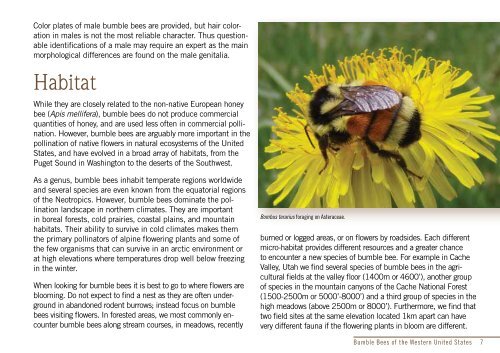Bumble Bees of the Western United States - USDA Forest Service
Bumble Bees of the Western United States - USDA Forest Service
Bumble Bees of the Western United States - USDA Forest Service
- No tags were found...
You also want an ePaper? Increase the reach of your titles
YUMPU automatically turns print PDFs into web optimized ePapers that Google loves.
Color plates <strong>of</strong> male bumble bees are provided, but hair colorationin males is not <strong>the</strong> most reliable character. Thus questionableidentifications <strong>of</strong> a male may require an expert as <strong>the</strong> mainmorphological differences are found on <strong>the</strong> male genitalia.HabitatWhile <strong>the</strong>y are closely related to <strong>the</strong> non-native European honeybee (Apis mellifera), bumble bees do not produce commercialquantities <strong>of</strong> honey, and are used less <strong>of</strong>ten in commercial pollination.However, bumble bees are arguably more important in <strong>the</strong>pollination <strong>of</strong> native flowers in natural ecosystems <strong>of</strong> <strong>the</strong> <strong>United</strong><strong>States</strong>, and have evolved in a broad array <strong>of</strong> habitats, from <strong>the</strong>Puget Sound in Washington to <strong>the</strong> deserts <strong>of</strong> <strong>the</strong> Southwest.As a genus, bumble bees inhabit temperate regions worldwideand several species are even known from <strong>the</strong> equatorial regions<strong>of</strong> <strong>the</strong> Neotropics. However, bumble bees dominate <strong>the</strong> pollinationlandscape in nor<strong>the</strong>rn climates. They are importantin boreal forests, cold prairies, coastal plains, and mountainhabitats. Their ability to survive in cold climates makes <strong>the</strong>m<strong>the</strong> primary pollinators <strong>of</strong> alpine flowering plants and some <strong>of</strong><strong>the</strong> few organisms that can survive in an arctic environment orat high elevations where temperatures drop well below freezingin <strong>the</strong> winter.When looking for bumble bees it is best to go to where flowers areblooming. Do not expect to find a nest as <strong>the</strong>y are <strong>of</strong>ten undergroundin abandoned rodent burrows; instead focus on bumblebees visiting flowers. In forested areas, we most commonly encounterbumble bees along stream courses, in meadows, recentlyBombus terarius foraging on Asteraceae.burned or logged areas, or on flowers by roadsides. Each differentmicro-habitat provides different resources and a greater chanceto encounter a new species <strong>of</strong> bumble bee. For example in CacheValley, Utah we find several species <strong>of</strong> bumble bees in <strong>the</strong> agriculturalfields at <strong>the</strong> valley floor (1400m or 4600’), ano<strong>the</strong>r group<strong>of</strong> species in <strong>the</strong> mountain canyons <strong>of</strong> <strong>the</strong> Cache National <strong>Forest</strong>(1500-2500m or 5000’-8000’) and a third group <strong>of</strong> species in <strong>the</strong>high meadows (above 2500m or 8000’). Fur<strong>the</strong>rmore, we find thattwo field sites at <strong>the</strong> same elevation located 1km apart can havevery different fauna if <strong>the</strong> flowering plants in bloom are different.<strong>Bumble</strong> <strong>Bees</strong> <strong>of</strong> <strong>the</strong> <strong>Western</strong> <strong>United</strong> <strong>States</strong> 7
















